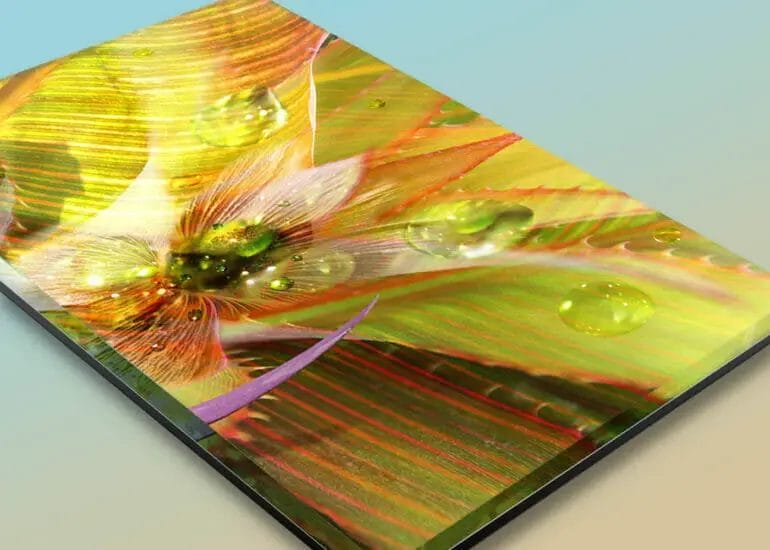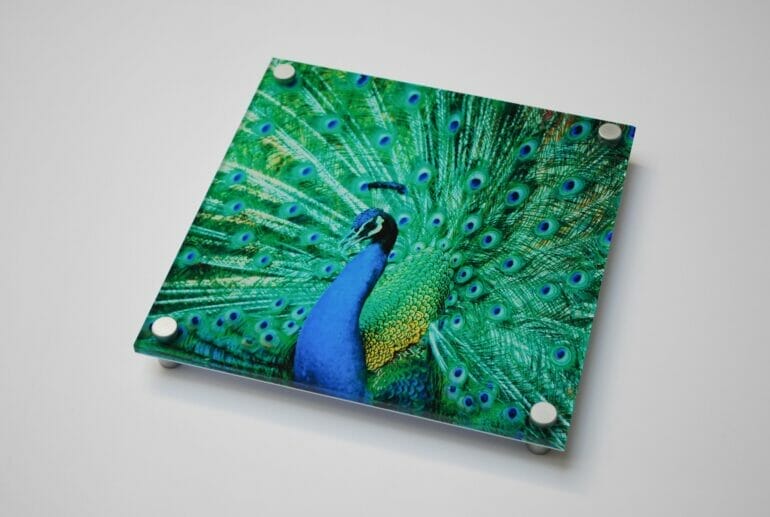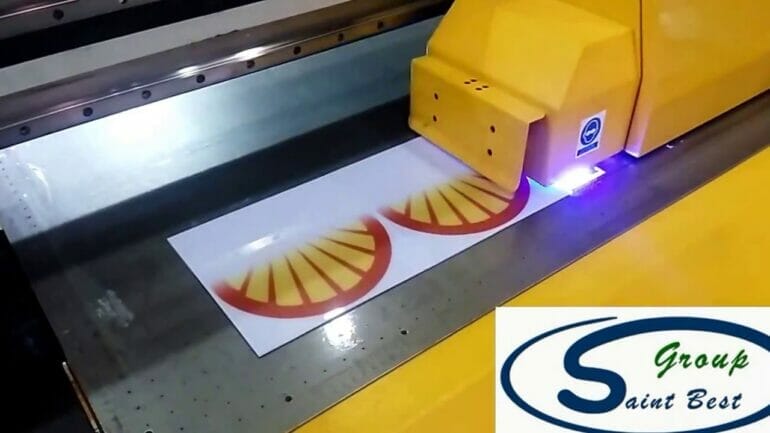If you’re looking to print on acrylic sheets at home, you’re in luck! With the right materials and techniques, you can create stunning and professional-looking prints on this versatile material. Whether you want to display artwork, photographs, or signage, printing on acrylic sheets can provide a sleek and modern aesthetic. In this article, we’ll guide you through the process of printing on acrylic sheets, from preparing the artwork to transferring it onto the surface with precision. Let’s get started!

Best Printer for Printing on Acrylic Sheets
When it comes to printing on acrylic sheets, having the right printer is crucial to achieve high-quality and professional results. Acrylic sheets offer a unique medium for printing, as they provide a smooth and glossy surface that enhances the visual appeal of the printed artwork or designs. In this section, we will explore the best printers that are specifically designed for printing on acrylic sheets.
Epson SureColor P800
The Epson SureColor P800 is a popular choice among professionals who require exceptional print quality on various media types, including acrylic sheets. With its advanced print head technology and UltraChrome HD pigment ink, this printer delivers stunning color accuracy and sharp details. It also offers an expanded color gamut, allowing you to reproduce vibrant and eye-catching prints on acrylic sheets.
Furthermore, the Epson SureColor P800 supports different paper thicknesses, including thick and rigid materials like acrylic sheets. Its fine art printing capabilities ensure that your prints on acrylic sheets retain their clarity and beauty. Additionally, this printer has a wide color range and easy-to-use controls, making it an excellent choice for both beginners and professionals.
Canon imagePROGRAF PRO-4000
The Canon imagePROGRAF PRO-4000 is another top contender for printing on acrylic sheets. This large-format printer boasts an 11-color LUCIA PRO pigment ink system, which delivers exceptional color accuracy and smooth gradations. Its high-density printhead allows for precise and detailed prints on various media, including acrylic sheets.
The Canon imagePROGRAF PRO-4000 also features a built-in color calibration system, ensuring consistent and accurate color reproduction. It has a user-friendly interface and advanced media handling capabilities, making it suitable for professionals in the photography, graphic design, and fine art industries. Whether you’re printing photographs, artwork, or signage on acrylic sheets, this printer can meet your needs.
Roland VersaUV LEF-12i
If you’re looking for a printer that is specifically designed for printing on delicate and curved surfaces like acrylic sheets, the Roland VersaUV LEF-12i is an excellent choice. This UV LED flatbed printer offers outstanding print quality and durability. It utilizes UV-curable inks that bond directly to the surface of acrylic sheets, resulting in vibrant and long-lasting prints.
The Roland VersaUV LEF-12i also features a unique height adjuster, allowing you to print on thick and uneven surfaces with ease. It provides precise color management and supports white and gloss ink options, enabling you to add special effects and finishes to your prints on acrylic sheets. Whether you’re producing custom promotional items, personalized gifts, or signage, this printer can handle the job efficiently.
Summary
When it comes to printing on acrylic sheets, investing in a high-quality printer is essential to achieve the best results. The Epson SureColor P800, Canon imagePROGRAF PRO-4000, and Roland VersaUV LEF-12i are among the top printers specifically designed for this purpose.
The Epson SureColor P800 offers exceptional print quality and a wide color gamut, making it suitable for a variety of applications. The Canon imagePROGRAF PRO-4000 excels in color accuracy and is equipped with advanced media handling capabilities. On the other hand, the Roland VersaUV LEF-12i specializes in printing on delicate and curved surfaces, providing vibrant and durable prints.
Consider your specific printing needs and budget when selecting the best printer for printing on acrylic sheets. With any of these options, you can confidently create stunning prints on this unique medium.

Tips and Tricks for Printing on Acrylic at Home
Printing on acrylic can be a great way to create stunning artwork, personalized gifts, or promotional materials. However, it can also be a challenging process if you don’t have the right techniques and tools. In this section, we will provide you with some tips and tricks to help you successfully print on acrylic at home.
1. Choose the Right Printer
The first step in printing on acrylic is to ensure you have a printer that is compatible with this material. Not all printers are designed to handle acrylic, so it’s important to do your research and find one that is specifically built for printing on rigid surfaces. Look for a printer that has a flatbed design and supports acrylic printing.
2. Prepare the Acrylic Surface
Before printing on acrylic, it’s crucial to properly prepare the surface to ensure optimal print quality. Start by cleaning the acrylic sheet thoroughly using a mild detergent and a soft cloth. This will remove any dust, dirt, or fingerprints that could affect the print. Once the surface is clean, use a lint-free cloth to dry it completely.
Next, apply an acrylic primer or a specialized inkjet coating to the surface. This coating will improve ink adhesion and prevent smudging or fading. Follow the manufacturer’s instructions when applying the primer or coating, and allow it to dry completely before proceeding to the next step.
3. Use the Right Ink
When printing on acrylic, it’s essential to use the right type of ink to achieve the best results. Acrylic-compatible inks are specifically formulated to adhere to the surface of acrylic and provide vibrant, long-lasting prints. These inks are typically UV resistant and waterproof, ensuring that your prints stay vibrant and fade-resistant over time.
4. Adjust Printer Settings
To ensure optimal print quality, it’s important to adjust the printer settings according to the thickness of your acrylic sheet. Most printers have settings for different material thicknesses, so make sure to select the appropriate option. This will help prevent any issues with ink smudging or uneven printing.
Additionally, consider adjusting the print resolution and color settings to achieve the desired level of detail and color accuracy. Experiment with different settings and perform test prints to find the optimal configuration for your specific project.
5. Allow Sufficient Drying Time
After printing, it’s crucial to allow sufficient drying time for the ink to fully bond with the acrylic surface. Failure to do so can result in smudging or scratching of the print. The drying time can vary depending on factors such as ink type, humidity, and temperature. As a general rule, it’s recommended to let the print dry for at least 24 hours before handling or displaying it.
6. Consider Post-Printing Finishes
Once the print is dry, you may want to consider applying a protective finish to enhance its durability and appearance. Options for post-printing finishes include clear acrylic spray, UV-resistant coatings, or laminates. These finishes can add an extra layer of protection against scratches, fading, and UV damage.
7. Experiment and Practice
Printing on acrylic can be a trial-and-error process, especially if you’re new to it. It’s important to experiment with different techniques, settings, and materials to find what works best for you. Don’t be afraid to make mistakes and learn from them. With practice, you’ll become more confident and skilled in printing on acrylic.
By following these tips and tricks, you’ll be well-equipped to create stunning prints on acrylic right from the comfort of your own home. Remember to always prioritize safety and carefully read the instructions provided by your printer and ink manufacturers. Happy printing!

Choosing the Right Ink for Acrylic Printing
When it comes to printing on acrylic surfaces, choosing the right ink is crucial for achieving high-quality and long-lasting results. The type of ink you use can greatly impact the adhesion, color vibrancy, and durability of your prints. In this section, we will explore the different types of inks available for acrylic printing and provide some tips on how to choose the best ink for your specific needs.
1. Solvent-based Inks
Solvent-based inks are one of the most commonly used inks for acrylic printing. These inks are made up of pigments or dyes dissolved in a solvent, which evaporates during the printing process. Solvent-based inks provide excellent adhesion to acrylic surfaces and offer vibrant colors. They are also highly resistant to fading and UV damage, making them ideal for outdoor applications. However, it is important to note that solvent-based inks emit volatile organic compounds (VOCs) during printing, which can be harmful to the environment and require proper ventilation.
2. UV-curable Inks
UV-curable inks have gained popularity in recent years for acrylic printing due to their fast curing time and high adhesion properties. These inks are cured using ultraviolet (UV) light, which instantly solidifies the ink upon contact with the acrylic surface. UV-curable inks offer excellent color gamut and sharpness, making them suitable for detailed and high-resolution prints. They also provide superior scratch and abrasion resistance, ensuring the longevity of your prints. However, UV-curable inks can be more expensive compared to other ink types and may require specialized equipment for curing.
3. Water-based Inks
Water-based inks are an eco-friendly alternative for acrylic printing. These inks utilize water as a solvent instead of harsh chemicals, making them safer to use and better for the environment. Water-based inks offer good adhesion to acrylic surfaces and provide vibrant colors. They are also odorless and have low VOC emissions, making them suitable for indoor applications and environments with limited ventilation. However, water-based inks may have slower drying times compared to solvent-based or UV-curable inks, and they may require additional coating or sealing for better durability.
4. Pigment Inks
Pigment inks consist of tiny solid particles suspended in a liquid carrier. These inks offer excellent color saturation and longevity, making them ideal for archival and fine art prints on acrylic surfaces. Pigment inks provide enhanced color accuracy and resistance to fading or color shifts over time. They also offer better lightfastness and are less susceptible to UV damage compared to dye-based inks. However, it is important to note that some pigment inks may require pre-treatment or coating of the acrylic surface to ensure proper adhesion.
5. Dye-based Inks
Dye-based inks are composed of liquid colorants that are absorbed into the acrylic surface. These inks offer a wide color gamut and vibrant prints, making them suitable for applications where color fidelity is essential. Dye-based inks typically have faster drying times compared to pigment inks and can be more cost-effective. However, they may be less resistant to fading and UV damage, making them more suitable for indoor or short-term applications. It is also important to note that dye-based inks can be prone to smudging if not properly handled or sealed.
Summary
Choosing the right ink for acrylic printing is essential for achieving the desired results in terms of adhesion, color vibrancy, and durability. Solvent-based inks offer excellent adhesion and UV resistance but emit VOCs. UV-curable inks provide fast curing and superior scratch resistance but can be more expensive. Water-based inks are eco-friendly and safe to use but may have longer drying times. Pigment inks offer exceptional color accuracy and longevity but may require pre-treatment. Dye-based inks provide vibrant colors and fast drying times but may be less resistant to fading and UV damage. Consider your specific requirements and application when selecting the ink type for your acrylic prints.
Common Mistakes to Avoid When Printing on Acrylic Sheets
Printing on acrylic sheets can be a great way to create stunning visuals and unique designs. However, there are some common mistakes that people often make when attempting to print on acrylic. These mistakes can lead to poor print quality, wasted materials, and costly errors. To ensure that your acrylic printing project is a success, it is important to be aware of these common mistakes and avoid them. In this section, we will discuss five common mistakes to avoid when printing on acrylic sheets.
1. Using the Wrong Ink
One of the most common mistakes when printing on acrylic sheets is using the wrong type of ink. Acrylic sheets are non-porous, which means that traditional inks may not adhere properly to the surface. It is essential to use ink that is specifically formulated for printing on non-porous materials like acrylic. UV-curable inks are highly recommended for printing on acrylic sheets as they dry quickly and form a durable bond with the surface.
2. Improper Cleaning and Preparation
Before printing on acrylic sheets, it is crucial to ensure that the surface is clean and free from any dust, dirt, or oils. Failure to properly clean and prepare the acrylic sheet can result in poor print quality and adhesion issues. Use a mild detergent or acrylic cleaner to clean the surface thoroughly and then wipe it dry with a clean, lint-free cloth. Additionally, be sure to handle the acrylic sheets with gloves to avoid leaving fingerprints or smudges.
3. Incorrect Printing Settings
Another common mistake is using incorrect printing settings. The settings for printing on acrylic sheets may differ from those used for other materials. Take the time to adjust the printer settings to match the characteristics of the acrylic sheets, such as the thickness and the specific ink being used. It is advisable to perform test prints on a small section of the acrylic sheet before proceeding with the full print to ensure that the settings are correct.
4. Inadequate Masking or Protection
When printing on acrylic sheets, it is important to use masking or protective materials to prevent damage to the surface. Masking tape or a protective film can be applied to the areas where the ink will be printed to protect the rest of the sheet from scratches or excess ink. Proper masking or protection ensures that the final print is clean and free from unwanted marks.
5. Poor File Preparation
Preparing the print file correctly is crucial for achieving high-quality results when printing on acrylic sheets. Make sure that the file is set to the correct dimensions and resolution for the desired print size. Additionally, ensure that the colors are accurately represented and that any text or logos are properly aligned. It is recommended to work with a professional graphic designer or printing service to ensure that the file is optimized for acrylic printing.
In summary, printing on acrylic sheets can produce impressive results when done correctly. To avoid common mistakes and ensure a successful acrylic printing project, always use the appropriate ink, clean and prepare the surface properly, adjust printing settings accordingly, use masking or protective materials, and prepare the print file accurately. By following these guidelines, you can achieve vibrant and durable prints on acrylic sheets.
FAQs
Can I print on acrylic sheets at home?
Yes, you can print on acrylic sheets at home using an inkjet printer. Make sure to use a printer that supports printing on thick materials. Clean the acrylic sheet thoroughly, adjust printer settings for optimal quality, and allow the print to dry before handling.
What type of printer is best for printing on acrylic sheets?
An inkjet printer is best for printing on acrylic sheets at home. Look for a printer that has a flatbed design to accommodate the thickness of the acrylic sheet. Additionally, ensure that the printer supports printing on non-traditional materials.
Are there any special precautions I should take when printing on acrylic sheets?
Yes, there are a few precautions to keep in mind. Firstly, ensure that the acrylic sheet is clean and free from any dust or debris that could affect the print quality. Secondly, handle the sheet carefully to avoid any scratches or smudges on the printed surface. Lastly, allow the print to fully dry before handling or displaying the acrylic sheet.
Conclusion:
In conclusion, printing on acrylic sheets at home is an accessible and creative process that can add a unique touch to your projects. By following the right steps and using the appropriate materials, you can achieve professional-looking results from the comfort of your own home. Whether you’re looking to create personalized artwork, signage, or decorative items, printing on acrylic offers endless possibilities. Remember to properly prepare the surface, use high-quality ink and a suitable printer, and allow sufficient drying time for optimal results. With a little practice and experimentation, you’ll be able to showcase your creativity and enhance your home decor with stunning acrylic prints.
